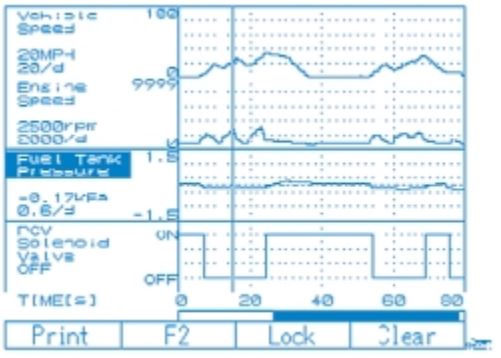Evaporative Emissions Testing Subaru:
The pressure control solenoid valve remains ON during this first part of the Evaporative Emissions Test. This indicates a leak in the evaporative emissions system, and the first part of the test has failed.

The results were quite different after the defective pressure control solenoid valve was replaced and the Enhanced Evaporative Emissions Test was repeated. When the pressure control solenoid valve was turned OFF, the fuel tank pressure reached -0.17 kPa. This indicates the system has been sealed and can be purged. The ECM recognizes the change in fuel tank pressure, and turns OFF the pressure control solenoid valve. The first part of the Enhanced Evaporative Emissions Test has passed.
To continue the Enhanced Evaporative Emissions Test, the vehicle was driven at a cruising speed between 45 and 80 mph. When the pressure control solenoid valve turned ON, the ECM recognized a fuel tank pressure change from negative to positive pressure, and the second part of the Enhanced Evaporative Emissions Test passed.
When the pressure control solenoid valve and vent solenoid valve are ON at the same time, the fuel tank pressure must drop to at least -1.333 kPa. The reading indicates -1.78 kPa, and the vehicle passes the third part of the Enhanced Evaporative Emissions Test.
The vent solenoid valve turns OFF and the low pressure in the fuel tank begins to rise toward atmospheric pressure. The fourth part of the Enhanced Evaporative Emissions Test has passed and the vehicle is successfully repaired.
The vehicle’s OBD-II monitors can be used as a final verification that replacing the pressure control solenoid valve has successfully repaired the vehicle’s evaporative emissions problem and resulting P0440 DTC.
OBD-II monitors are scheduled to run under very precise conditions. If these conditions are not met for any reason, the monitor simply will not run to completion.
The Subaru evaporative emissions system monitor is a ‘leak up’ system. This means the evaporative system is put under a slight vacuum, and the ECM measures how much the system pressure rises over time.
Before the evaporative systems monitor will run, the ECM must see a pressure change in the fuel tank when the vehicle is first started and you begin to drive. The fuel tank must be less than half full. The vehicle must be cruising over 45 mph, but below 80 mph.
